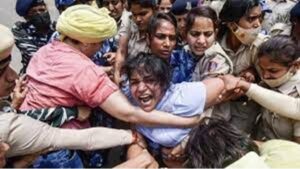Table of Contents
Introduction
The topic of unlawful assembly or section 144 IPC is highly relevant. People nowadays are more vocal and assertive about their opinions and ideas. But when people gather to protest, these protests can often turn violent, and the line between lawful and unlawful assembly becomes blurred. In this article, we will know the various provisions relating to unlawful assembly
Right to Assemble
Article 19 (1)(B) of the Constitution of India 1949, lay down that ‘All citizens shall have right to assemble peaceably and without arms. That means citizens of India have been given the freedom to assemble and organize public gatherings or even processions of their own will. But this right to assemble is subject to reasonable restriction by the state in the interest of the sovereignty and integrity of India or public order under clause 3 of Article 19 of the Constitution of India 1949.
What is an Unlawful Assembly?
Chapter VIII of the Indian Penal Code contains provisions relating to unlawful assembly. The offense of unlawful assembly is cognizable but available. The term ‘Unlawful Assembly’ has been defined under section 141 of the Indian Penal Code, 1860 as an assembly of five or more persons having a common object to perform an omission or offence.
To constitute an unlawful assembly the following 3 conditions must co-exist:-
- There must be an assembly of five persons.
- The assembly must have a common object and
- The common object must be to commit one of the five illegal objects specified in the section.

Unlawful Assembly Example
Ram and 4 of his friends decided to protest against a government policy. It is not an unlawful assembly if they are protesting, sitting silently, and showing their displeasure.
Suppose they decide to destroy public property to intimidate the Government for the decision. In that case, all 5 of them are part of unlawful assembly and will be liable to punishment under the Indian Penal Code.
Section 149 of the IPC clearly states that if an offence is committed to prosecuting a common object, then every member of an unlawful assembly sharing such object will be guilty of it.
Punishment for unlawful assembly under IPC
i) Under Section 143 of I.P.C. whoever is a member of an unlawful assembly shall be punished with imprisonment of either description for a term which may extend to six months, or with fine, or with both.
ii) Under Section 144 of I.P.C. whoever joins unlawful assembly armed with a deadly weapon that is likely to cause death; shall be punished with imprisonment for two years, or fine, or both.
iii) Under Section 145 of I.P.C. whoever joins or continues to be in unlawful assembly, knowing it has been commanded to disperse, shall be punished with imprisonment for 2 years, or fine, or both.
iv) Under Section 149 of I.P.C. where an assembly commits an offence then every member of that unlawful assembly, who knew such offence is likely to be committed, will be guilty of that offence. And be punished for the term same as for the offence.
Unlawful Assembly Provision under CrPC
- By Civil Force (Section 129): The Executive Magistrate or officer in charge of a police station may command an assembly to disperse if it is a chance that it will disrupt public peace or is already an unlawful assembly. But can a police officer make arrests if assembly members refuse to disperse? Yes. If necessary, police can arrest the members of unlawful assembly.
- By Armed Force (Section 130): If the unlawful assembly is not dispersing, then, for public security, the Executive Magistrate of the highest rank may order it to disperse by the armed forces.
MUST READ
WHAT IS THE RIGHT TO PROPERTY IN INDIA?
